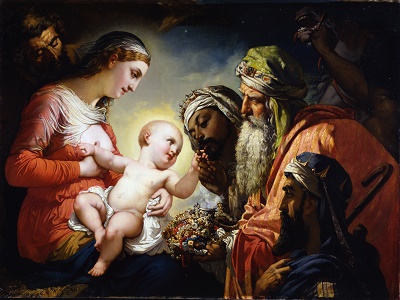Henri Lehmann (German/French, 1814–1882)
The Adoration of the Magi, 1854
Oil on canvas, 38 3/4 x 51 3/8 in.
Signed and dated lower left: Henri Lehmann, 1854
2003.5

Lehmann was born in the northern German province of Schleswig, but had a major presence in the French art world of the 19th century. After training from his father Leo, a reputable portraitist, and other artists in Hamburg, Lehmann traveled to Paris in 1831 to study under Jean-Auguste-Dominique Ingres, the first of many important relationships that influenced his art and career. In 1838, he went to Rome, where Ingres was the director of the French Academy at the Villa Medici and became friends with the painter Théodore Chassériau, fellow German artists Josef Anton Koch and Johann Friedrich Overbeck, and Franz Liszt and Marie d’Agoult, with whom he maintained correspondence for many years.
Lehmann created mural programs for a number of churches in Paris, but Adoration of the Magi was probably created for the home of a wealthy patron or a small chapel. In his depiction of the Magi (the three wise kings who followed the star to Bethlehem), Lehmann observes the tradition of Peter Paul Rubens, who was among the earliest Western artists to use physiognomy and costume to differentiate the Magi figures. Critic Théophile Gautier praised Lehmann’s ethnographic efforts, but the artist also remained true to his master, giving the Virgin a classical profile of which Ingres would surely approve. At the same time, as a reviewer for the L’Artiste noted, Lehmann “reconciled fidelity to his master’s doctrines with a desire to be more modern.”


